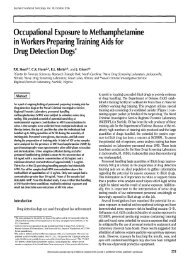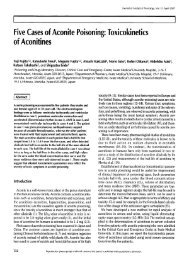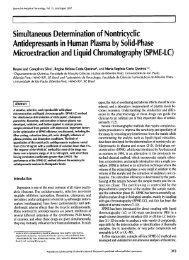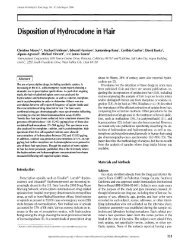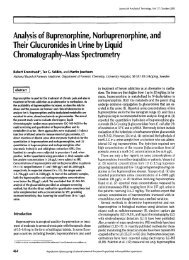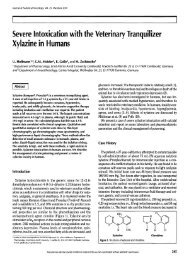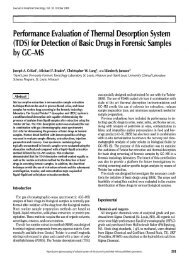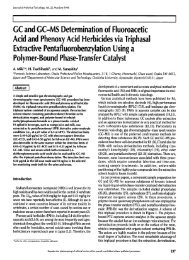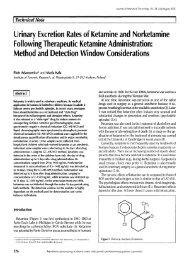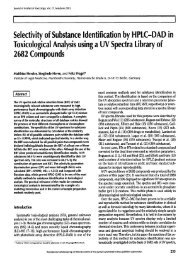Technical Note ] Importance of Vacutainer Selection in Forensic ...
Technical Note ] Importance of Vacutainer Selection in Forensic ...
Technical Note ] Importance of Vacutainer Selection in Forensic ...
Create successful ePaper yourself
Turn your PDF publications into a flip-book with our unique Google optimized e-Paper software.
types; GC-MS signals <strong>of</strong> analytes and matrix compounds <strong>in</strong> SIM<br />
mode showed no differences. No differences <strong>in</strong> the quantitative<br />
results could be found for the analytes amphetam<strong>in</strong>e (49 cases),<br />
MDMA (23 cases), MDA (16 cases), morph<strong>in</strong>e (14 cases), code<strong>in</strong>e<br />
(13 cases), dihydrocode<strong>in</strong>e (3 cases), THC (35 cases), and THC-<br />
OH (32 cases). However, clear differences were observed for<br />
coca<strong>in</strong>e, its metabolites (29 cases), and THCCOOH (45 cases) as<br />
shown <strong>in</strong> Figure 1.<br />
Stability <strong>of</strong> coca<strong>in</strong>e and its metabolites <strong>in</strong> serum/plasma<br />
In 29 cases, benzoylecgon<strong>in</strong>e was determ<strong>in</strong>ed as evidence <strong>of</strong><br />
previous coca<strong>in</strong>e use. Coca<strong>in</strong>e itself was not found <strong>in</strong> any <strong>of</strong> the<br />
normal samples, but <strong>in</strong> 65% <strong>of</strong> the fluoride samples. Coc-<br />
aethylene was present <strong>in</strong> two <strong>of</strong> the fluoride samples (8%), con-<br />
firm<strong>in</strong>g that fluoride has a stabiliz<strong>in</strong>g effect on coca<strong>in</strong>e and<br />
cocaethylene. It was surpris<strong>in</strong>g that the concentrations <strong>of</strong> ben-<br />
zoylecgon<strong>in</strong>e <strong>in</strong> the fluoride samples were almost twice as high<br />
(compare immunological results) and those <strong>of</strong> ecgon<strong>in</strong>e<br />
methylester were almost half when compared to those <strong>of</strong> the<br />
normal samples (Figure 1).<br />
In serum without additives, coca<strong>in</strong>e is rapidly hydrolyzed enzy-<br />
matically to ecgon<strong>in</strong>e methylester as has been shown <strong>in</strong> various<br />
studies (3) and <strong>in</strong> the present study (Figure 2). In contrast to<br />
Isenschmid et al. (3), it was found that coca<strong>in</strong>e was also<br />
hydrolyzed to benzoylecgon<strong>in</strong>e, but only to a m<strong>in</strong>or extent, which<br />
is <strong>in</strong> accordance with Stewart et al. (11). Ecgon<strong>in</strong>e methylester<br />
and benzoylecgon<strong>in</strong>e were also <strong>in</strong>stable and were further<br />
hydrolyzed to ecgon<strong>in</strong>e. The overall degradation process could be<br />
assessed by add<strong>in</strong>g the molar concentrations <strong>of</strong> coca<strong>in</strong>e, ecgon<strong>in</strong>e<br />
methylester, and benzoylecgon<strong>in</strong>e and perform<strong>in</strong>g an exponential<br />
regression analysis which yielded a half-life <strong>of</strong> 15 h (equation:<br />
y = 4.22 e 4)'0462 x x, regression coefficient 0.991, Figure 2).<br />
The differences observed between the data obta<strong>in</strong>ed by ana-<br />
lyz<strong>in</strong>g the normal and the fluoride samples are ma<strong>in</strong>ly due to the<br />
fluoride-mediated <strong>in</strong>hibition <strong>of</strong> the plasma chol<strong>in</strong>esterase<br />
(PChE). Consequently, ecgon<strong>in</strong>e methylester concentrations<br />
were lower <strong>in</strong> the fluoride samples because enzymatic hydrolysis<br />
<strong>of</strong> coca<strong>in</strong>e to ecgon<strong>in</strong>e methylester was <strong>in</strong>hibited.<br />
The literature reports on the stability <strong>of</strong> benzoylecgon<strong>in</strong>e are<br />
35%<br />
0 25%<br />
"o ~ 20%<br />
P<br />
15%<br />
,o%<br />
=<br />
I-- 0%<br />
0 50 I00 150 200 250<br />
Incubation time (h)<br />
Figure 3. Percentage <strong>of</strong> hydrolyzed THCCOOH-glucuronide <strong>in</strong> serum from<br />
normal <strong>Vacuta<strong>in</strong>er</strong>s (O) and <strong>in</strong> plasma from <strong>Vacuta<strong>in</strong>er</strong>s conta<strong>in</strong><strong>in</strong>g<br />
fluoride/oxalate (I-l) at 25~ For each type <strong>of</strong> material are shown the average<br />
and standard deviation from three different concentrations <strong>of</strong> THCCOOHg[ucuronide<br />
(37.8, 75.6, and 151.2 ng/mL spiked).<br />
342<br />
Duma[ <strong>of</strong> Analytical Toxicology, Vo[. 25, July/August 2001<br />
controversial. An enzymatic hydrolysis <strong>of</strong> benzoylecgon<strong>in</strong>e to<br />
ecgon<strong>in</strong>e like coca<strong>in</strong>e to ecgon<strong>in</strong>e methylester could be expected;<br />
however, some authors suggest that benzoylecgon<strong>in</strong>e is stable <strong>in</strong><br />
unpreserved serum (3,8,12). Stewart et al. (11) found a constant,<br />
but slow hydrolysis <strong>in</strong> unstabilized serum samples that was<br />
expla<strong>in</strong>ed by a low aff<strong>in</strong>ity <strong>of</strong> benzoylecgon<strong>in</strong>e to the enzyme<br />
PChE. Giorgi and Meeker (7) and Moody et al. (13) reported a sub-<br />
stantial decrease <strong>of</strong> benzoylecgon<strong>in</strong>e concentrations <strong>in</strong> blood sam-<br />
ples stabilized with fluoride, but Baselt et al. (5) reported that<br />
benzoylecgon<strong>in</strong>e was stable <strong>in</strong> blood for one year <strong>in</strong> evacuated col-<br />
lection tubes conta<strong>in</strong><strong>in</strong>g 100 mg sodium fluoride and 20 mg potas-<br />
sium oxalate. Therefore, an experiment was performed <strong>in</strong> order to<br />
test the stability <strong>of</strong> benzoylecgon<strong>in</strong>e <strong>in</strong> unstabilized serum. A<br />
sample conta<strong>in</strong><strong>in</strong>g benzoylecgon<strong>in</strong>e <strong>in</strong> a concentration <strong>of</strong> 1000<br />
ng/mL and <strong>in</strong>cubated at 25~ exhibited a l<strong>in</strong>ear decrease <strong>of</strong> 13 ng<br />
BZE/mL per hour (regression coefficient 0.997). The benzoylecgo-<br />
n<strong>in</strong>e concentration was reduced to almost half <strong>of</strong> the <strong>in</strong>itial value<br />
dur<strong>in</strong>g the 38 h <strong>of</strong> <strong>in</strong>cubation. Such a delay may be reached easily<br />
when a blood sample is sent by mail. The observed differences <strong>of</strong><br />
the benzoylecgon<strong>in</strong>e concentrations between the normal samples<br />
and the fluoride samples can therefore be expla<strong>in</strong>ed by the hydro-<br />
lysis <strong>of</strong> benzoylecgon<strong>in</strong>e <strong>in</strong> unpreserved samples.<br />
Stability <strong>of</strong> THCCOOH-glucuronide <strong>in</strong> serum/plasma<br />
The cannab<strong>in</strong>oid immunoassay is designed to measure THC-<br />
COOH. The observation that the immunological values <strong>in</strong> the flu-<br />
oride samples were about half as high as <strong>in</strong> the normal samples<br />
could be expla<strong>in</strong>ed by the f<strong>in</strong>d<strong>in</strong>g that hemolysis <strong>in</strong> the fluoride<br />
samples markedly affects FPIA measurement. Surpris<strong>in</strong>gly, the<br />
GC-MS confirmation analyses showed that, <strong>in</strong> 90% <strong>of</strong> the fluoride<br />
samples, the THCCOOH concentrations were on average 32%<br />
lower than <strong>in</strong> the normal samples. Previous studies suggested<br />
that THC, THC-OH, and THCCOOI-I are stable <strong>in</strong> blood and<br />
plasma dur<strong>in</strong>g storage for several months (8,13-17). A possible<br />
explanation for our f<strong>in</strong>d<strong>in</strong>g would be a conjugate <strong>of</strong> THCCOOH<br />
that is unstable, probably susceptible to degradation by serum<br />
esterases. Such a metabolite could be the ester glucuronide <strong>of</strong><br />
THCCOOH (18) (THCCOOH-glucuronide). Therefore, we <strong>in</strong>vesti-<br />
gated the stability <strong>of</strong> the THCCOOH-glucuronide <strong>in</strong> blood sam-<br />
ples with and without stabiliz<strong>in</strong>g agents.<br />
The THCCOOH-glucuronide was stable under the conditions <strong>of</strong><br />
the analytical procedure as immediately after spik<strong>in</strong>g <strong>of</strong> the sam-<br />
ples no THCCOOH was detectable. No THCCOOH developed<br />
dur<strong>in</strong>g the <strong>in</strong>cubation <strong>of</strong> THCCOOH-glucuronide <strong>in</strong> suspended<br />
erythrocytes, <strong>in</strong>dicat<strong>in</strong>g that the erythrocytes had no <strong>in</strong>fluence on<br />
the stability <strong>of</strong> the glucuronide. Dur<strong>in</strong>g <strong>in</strong>cubation <strong>of</strong> THCCOOH-<br />
glucuronide <strong>in</strong> serum or fluoride/oxalate conta<strong>in</strong><strong>in</strong>g plasma,<br />
THCCOOH could be detected <strong>in</strong> <strong>in</strong>creas<strong>in</strong>g concentrations. The<br />
absolute concentrations were dependent on the <strong>in</strong>itial amount <strong>of</strong><br />
glucuronide but <strong>in</strong> each group (with or without fluoride/oxalate)<br />
the THCCOOH concentration relative to the maximum theoret-<br />
ical yield were reproducible (Figure 3). The concentrations at 139<br />
or 236 h <strong>in</strong>cubation time were significantly lower <strong>in</strong> the fluor-<br />
ide/oxalate plasma samples than <strong>in</strong> the unstabilized serum sam-<br />
ples (p < 0.01) prov<strong>in</strong>g that the addition <strong>of</strong> fluoride/oxalate had<br />
<strong>in</strong>deed a stabiliz<strong>in</strong>g effect on the THC metabolite THCCOOH-glu-<br />
curonide. This is probably the explanation for the lower concen-<br />
trations <strong>of</strong> THCCOOH <strong>in</strong> the fluoride samples.


![Technical Note ] Importance of Vacutainer Selection in Forensic ...](https://img.yumpu.com/6394704/4/500x640/technical-note-importance-of-vacutainer-selection-in-forensic-.jpg)
